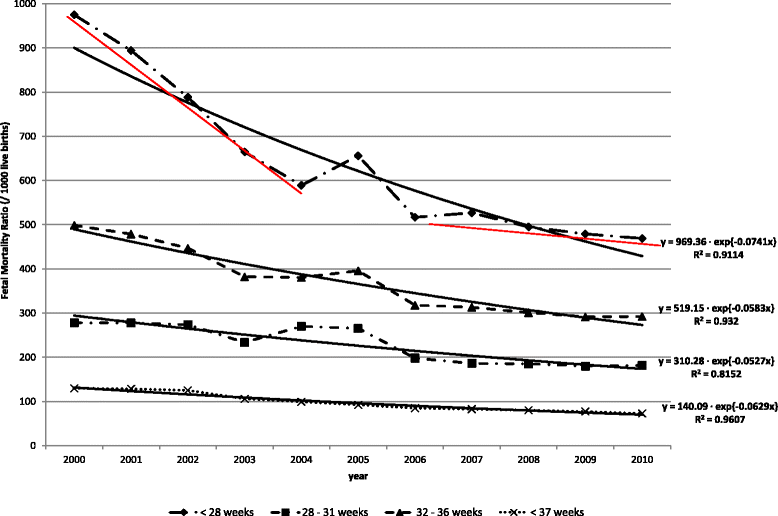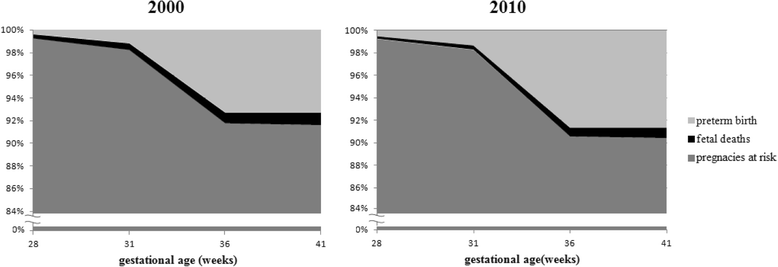What is the impact of interventions that prevent fetal mortality on the increase of preterm live births in the State of Sao Paulo, Brazil?
- PMID: 26201726
- PMCID: PMC4512015
- DOI: 10.1186/s12884-015-0572-6
What is the impact of interventions that prevent fetal mortality on the increase of preterm live births in the State of Sao Paulo, Brazil?
Abstract
Background: There is a global growing trend of preterm births and a decline trend of fetal deaths. Is there an impact of the decline of fetal mortality on the increase of preterm live births in State of Sao Paulo, Brazil?
Methods: The time trends were evaluated by gestational age through exponential regression analysis. Data analyzed included the fetal mortality ratio, proportion of preterm live births, fertility rate of women 35 years and over, prenatal care, mother's education, multiple births and cesarean section deliveries. A survival analysis was carried out for 2000 and 2010.
Results: Preterm births showed the highest annual increase (3.2%) in the less than 28 weeks of gestation group and fetal mortality ratio decreased (7.4%) in the same gestational age group. There was an increase of cesarean section births and it was higher in the < 28 weeks group (6.1%). There was a decreased annual trend of mothers with inadequate prenatal care (6.1%) and low education (8.8%) and an increased trend in multiple births and fertility rates of women of 35 years and over. The variables were highly correlated to which other over time. In 2000, 8.2% of all pregnancies resulted in preterm births (0.9% in fetal deaths and 7.3% in live births). In 2010, the preterm birth increased to 9.4% (0.8% were preterm fetal deaths and 8.6% preterm live births).
Conclusions: The results suggest that 45.2% could be the maximum contribution of successful interventions to prevent a fetal death on the increase in preterm live births. This increasing trend is also related to changes of the women reproductive profile with the change of the women reproductive profile and access to prenatal care.
Figures





Similar articles
-
Annual summary of vital statistics--2003.Pediatrics. 2005 Mar;115(3):619-34. doi: 10.1542/peds.2004-2695. Pediatrics. 2005. PMID: 15741364
-
Births: final data for 1997.Natl Vital Stat Rep. 1999 Apr 29;47(18):1-96. Natl Vital Stat Rep. 1999. PMID: 10334087
-
Assisted reproductive technology surveillance--United States, 2011.MMWR Surveill Summ. 2014 Nov 21;63(10):1-28. MMWR Surveill Summ. 2014. PMID: 25412164
-
The relationship between cesarean delivery and gestational age among US singleton births.Clin Perinatol. 2008 Jun;35(2):309-23, v-vi. doi: 10.1016/j.clp.2008.03.002. Clin Perinatol. 2008. PMID: 18456071 Review.
-
Cesarean section on request at 39 weeks: impact on shoulder dystocia, fetal trauma, neonatal encephalopathy, and intrauterine fetal demise.Semin Perinatol. 2006 Oct;30(5):276-87. doi: 10.1053/j.semperi.2006.07.009. Semin Perinatol. 2006. PMID: 17011400 Review.
Cited by
-
Factors associated with low birth weight at term: a population-based linkage study of the 100 million Brazilian cohort.BMC Pregnancy Childbirth. 2020 Sep 14;20(1):536. doi: 10.1186/s12884-020-03226-x. BMC Pregnancy Childbirth. 2020. PMID: 32928144 Free PMC article.
References
-
- Lawn JE, Gravett MG, Nunes TM, Rubens CE, Stanton C, GAPPS Review Group Global report on preterm birth and stillbirth (1of 7): definitions, description of the burden and opportunities to improve data. BMC Pregnancy Childbirth. 2010;10(Suppl 1):S1. doi: 10.1186/1471-2393-10-S1-S1. - DOI - PMC - PubMed
-
- Malta DC, Duarte LC, Escalante JJC, Almeida MF, Sardinha LM, Macário EM, et al. Avoidable causes of infant mortality in Brazil, 1997–2006: contributions to performance evaluation of the Unified National Health System. Cad Saúde Pública. 2010;26(3):481–491. doi: 10.1590/S0102-311X2010000300006. - DOI - PubMed
-
- Almeida MF, Alencar GP, Novaes HMD, França I, Jr, Siqueira AAF, Campbell OMR, et al. Risk factors for antepartum fetal deaths in São Paulo. Brazil Rev Saude Publica. 2007;41(1):35–43. - PubMed
Publication types
MeSH terms
LinkOut - more resources
Full Text Sources
Other Literature Sources

